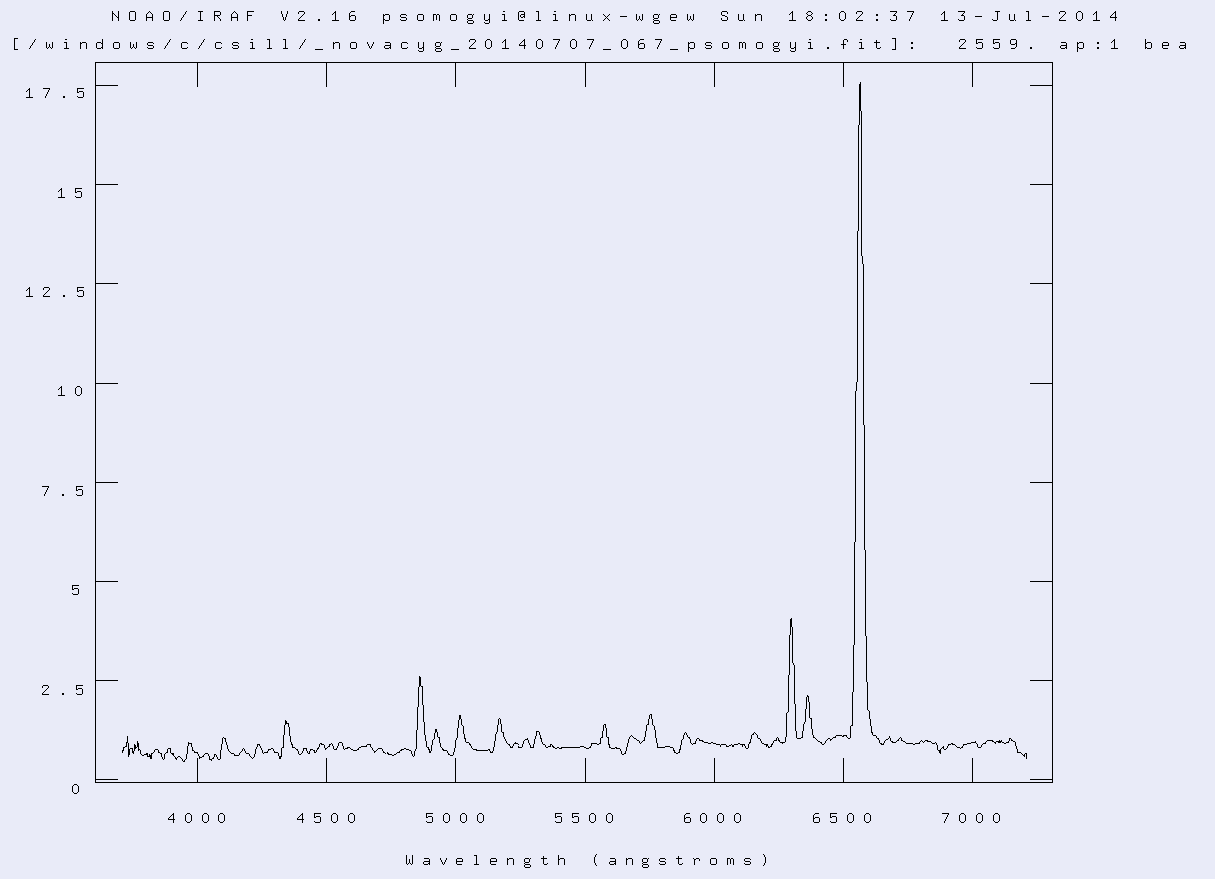Hi, just introduced myself, now sending the very first spectra Nova Cyg 2014 and being curious whether it's ok for the database (+ will have Z And and CI Cyg of the same night):

- nova cyg 2014
- _novacyg_20140707_067_psomogyi.png (9.71 KiB) Viewed 6441 times
I had to write a script to solve DATE-OBS field because the Orion studio puts there a different field "DATE_OBS" and in a non-standard format (using Orion Starshoot G3 mono as detector).
Reference star: 21-Vul (used for response curve and wavelength)
Response curve was a bit tricky to cope with, because I had to remove telluric holes above 6800A by hand for continuum fit, but I couldn't find any exact method for that, except that I would remove telluric lines completely by a simple divide + filter, but keeping telluric lines is a recommendation for this database.
So now telluric lines kept in the final profile as recommended, but manual intervention was needed for this case.
Flat was done by detaching Alpy from the scope on the table in a room, using halogen lamp, reflected from a white paper in front of the Alpy, experienced a cut in the UV when it were behind the paper.
I've downloaded a few other .fit files from database comparing to them, and looks similar, except that my resolution looks not enough to find the hole near Ha (near Hb it is OK).
ISIS log:
-----------------
Version : ISIS V5.4.1
Date du traitement : 08.07.2014 20:31:16
-----------------
Nom de l'objet traité : NovaCyg2014
Nom complet du fichier de l'objet traité : _novacyg2014_20140707_067.fit
Chemin de sauvegarde : c:\csill\20140706_fixed\
-----------------
Nom générique des spectres 2D bruts : c:\csill\20140706_fixed\07_novacyg-2014
Nombre de spectres bruts : 2
Offset : c:\csill\20140706_fixed\offset
Dark : c:\csill\20140706_fixed\dark
Coefficient du dark : 2.0000
Flat : c:\csill\20140706_fixed\flat
Etalonnage : mode standard
Spectre lampe étalon : c:\csill\20140706_fixed\08_21Vul45s-1
Position Y de référence : 276
Taille pixel : 8.6
Registration verticale : oui
Soustraction du fond de ciel : oui
Recentrage des spectres en longueur d'onde : non
Angle de slant : 262
Angle de tilt : 0.96
Retrait des rayons cosmiques : non
Limite X1 : 226
Limite X2 : 526
Fichier cosmétique : c:\csill\20140706_fixed\cosme
Filtre gaussien : 0
Fichier de réponse spectrale : resp_21vul
Fichier de transmission atmosphérique :
Décalage spectral : 0
Correction vitesse radiale : 0
Facteur de binning en sortie : 1
Indicatif du mode d'étalonnage : 31
Longueur d'onde de référence : 6562.81
Position X de référence : 609
Instrument : 25cmAlpy600OrionG3
Résolution :
Site : Tata
Observateur : psomogyi
Delta heure : 1
Ciel Y1 : 60
Ciel Y2 : 24
Ciel Y3 : 24
Ciel Y4 : 60
Largeur de la zone de binning : 40
Binning optimisé : oui
Coefficient de rejection des cosmiques pour le binning : 15
Zone de normalisation [Lambda 1 - Lambda 2] : [ 6630 - 6645 ]
Sommation standard des profils individuels
Interpollation : bilinéaire
A4 : 4.78181865727955E-10
A3 : -1.09102101621398E-06
A2 : 0.000519525911781899
A1 : 4.72164307172507
A0 : 3676.17633404314
-----------------
Date de prive de vue : 2014.07.07. 1:36:53
Durée de prise de vue : 2559.0
Durée de prise de vue décomposée : 2 x 1200 s
Date de milieu de prise de vue : 7.082/07/2014
Jour Julien géocentrique du milieu de prise de vue : 2456845.5821
Pouvoir de résolution : 0.0
RMS de l'étalonnage spectral : 0.35018